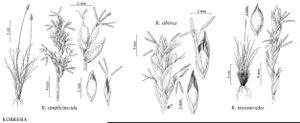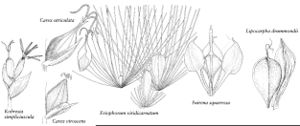Kobresia
Sp. Pl. 4(1): 205. 1805.
| Taxon | Illustrator ⠉ | |
|---|---|---|
 | Kobresia simpliciuscula Kobresia sibirica Kobresia myosuroides | Amanda Humphrey Amanda Humphrey Amanda Humphrey |
Herbs, perennial, cespitose, short-rhizomatous. Culms rounded-trigonous. Leaves basal and cauline; basal leaf-sheaths persistent; ligules present; blades involute to filiform. Inflorescences terminal, spicate or paniculate, simple or compound; spikelets mostly 10–30; proximal bracts subtending spikes leaflike or scalelike; bracts subtending spikelets scalelike. Spikelets: terminal and distal spikelets usually 1-flowered, staminate; proximal spikelets 1-flowered and pistillate, or 2–4-flowered and bisexual with 1 pistillate flower proximally and 1–3 staminate flowers distally, all enclosed by scalelike bract open to one side (perigynium), perigynium sometimes enclosing additional sterile scales. Flowers unisexual; perianth absent; stamens 3; styles linear, usually 3-fid, base persistent. Achenes usually trigonous, included in perygynium.
Distribution
Mainly high mountains of Asia, a few in arctic and subarctic regions and high mountains of Northern Hemisphere
Discussion
Species ca. 30 (3 in the flora).
See 26. Carex for a discussion of the inflorescence and flower structure of Kobresia. The inflorescences of Kobresia cannot be clearly divided into primary and secondary inflorescences as in most other genera of Cyperaceae. The proximal part of the inflorescence usually is composed of bisexual spikelets arranged on a simple axis or on a compact panicle. Distally there is a transition first to spikelets consisting only of a pistillate flower, then to staminate flowers subtended by the scale. In species with compound inflorescences this transition may also occur on the branches. In this account, for convenience, the structures subtended by a scale are all considered to be spikelets even though, as discussed in Carex, staminate flowers are considered to be a simple flower and not a reduced staminate inflorescence.
Selected References
None.
Lower Taxa
Key
| 1 | Perigynia 3.5–5.5 mm; scales 3.5–5 mm, midvein fading toward tip. | Kobresia sibirica |
| 1 | Perigynia 2–3.5 mm; scales 2–3.5 mm, midvein distinct almost to tip. | > 2 |
| 2 | Inflorescences usually compound, (2–)3–8 mm wide; basal sheaths persistent, dull, usually with remains of blades attached. | Kobresia simpliciuscula |
| 2 | Inflorescences simple, 2–3 mm wide; basal sheaths persistent, somewhat glossy, bladeless. | Kobresia myosuroides |
"shortened" is not a number.
